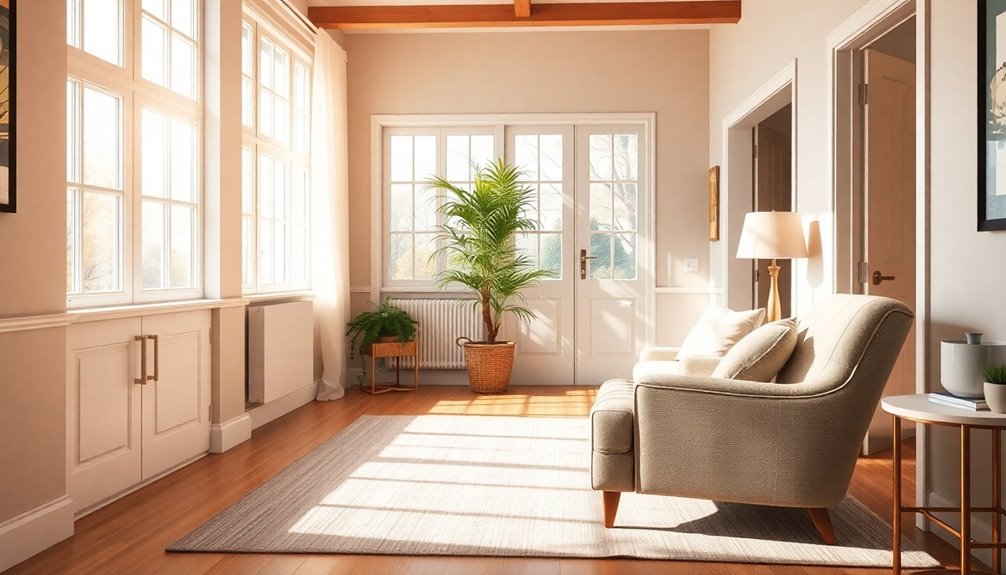To create a secure living space for older adults, focus on universal design principles. Install slip-resistant flooring and lever-style door handles for easy access. Enhance mobility with grab bars, smooth shifts, and ample lighting. Adapt bathrooms with walk-in showers and raised toilets for added safety. Don't forget to incorporate social spaces and community engagement features. With these essentials, you can boost comfort and well-being. Keep going to explore even more age-friendly design ideas!
Key Takeaways
- Implement slip-resistant flooring throughout the home to minimize fall risks for residents of all ages.
- Install grab bars in bathrooms and other strategic locations for added support and safety.
- Use lever-style door handles for easier access, accommodating individuals with limited grip strength.
- Ensure ample, glare-free lighting in high-traffic areas to enhance visibility and reduce accident risks.
- Design inclusive outdoor spaces with seating areas and community gardens to encourage social interaction and engagement.
Understanding Universal Design Principles for Home Modifications

When you think about home modifications, understanding universal design principles is essential for creating spaces that work for everyone, regardless of age or ability.
These principles focus on making your home environment safe and accessible for older adults, especially when considering aging in place. Key aspects include equitable use, flexibility, and simplicity, which enhance the overall quality of life.
By incorporating features like lever-style door handles, slip-resistant flooring, and strategically placed grab bars, you can notably reduce accident risks and improve mobility.
Universal design not only supports older adults but also benefits visitors and caregivers, ensuring a welcoming and adaptable space for all.
Adopting these principles creates a more inclusive home that meets everyone's needs effectively.
Creating Safe and Accessible Entryways for the Elderly
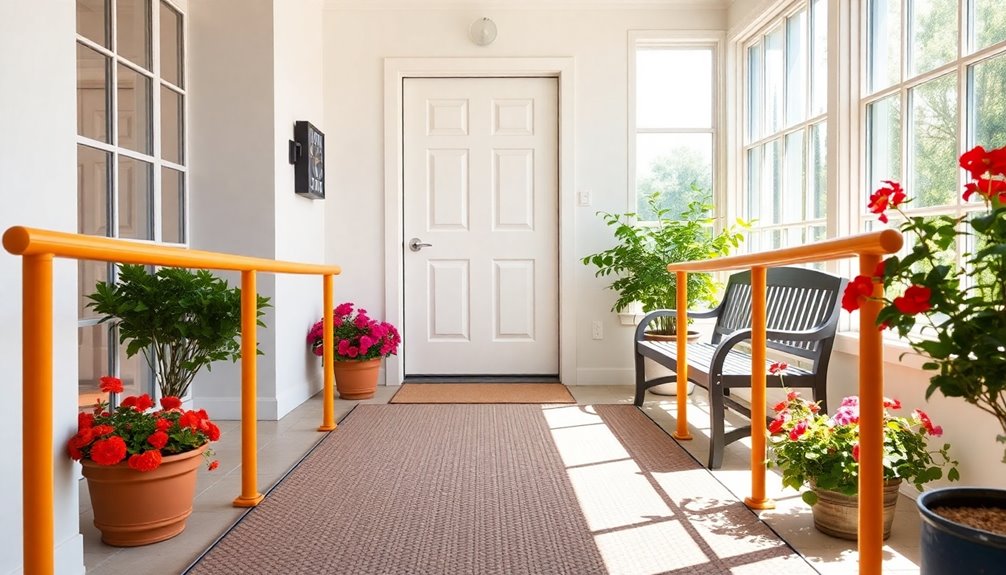
Creating safe and accessible entryways for older adults builds on the universal design principles that make homes more adaptable. Entryways serve as critical interchange points, so focus on safety and accessibility. Consider these key features:
| Feature | Benefits | Implementation |
|---|---|---|
| Slip-resistant flooring | Reduces fall risk | Use textured materials |
| Convenient landing places | Secure item placement | Add small tables or benches |
| Motion-sensor lights | Enhances nighttime visibility | Install automatic lighting |
Incorporating home security systems can further enhance safety for elderly residents. Additionally, ensuring that the entryway is heated with an eco-friendly solution, like a wood stove, can provide a warm and welcoming environment for older adults. Implementing regular maintenance of heat pumps ensures that the entryway remains comfortable and energy-efficient throughout the seasons.
Installing Proper Lighting for Enhanced Visibility

Proper lighting is essential for guaranteeing that older adults can navigate their homes safely and confidently.
By implementing smart lighting solutions, you can greatly enhance visibility and reduce the risk of falls. Air purifiers can also contribute to a healthier indoor environment by improving air quality and reducing allergens, which is especially beneficial for older adults. Regular use of HEPA filtration in air purifiers ensures that common allergens are effectively removed from the air.
Consider the following tips:
- Install bright, glare-free fixtures in entryways and high-traffic areas.
- Use motion-sensor lights to illuminate stairways and pathways automatically.
- Make sure walkways are well-lit to improve navigation.
- Highlight house numbers with adequate lighting for emergency responders.
- Incorporate task lighting in areas where older adults spend the most time.
Additionally, ensuring that spaces are free from obstacles can complement optimal usage timing of lighting enhancements, creating a safer environment that supports the independence and well-being of older adults, allowing them to move freely and confidently within their homes.
Adding Convenient Landing Places for Smooth Transitions

When you incorporate convenient landing places like small tables or benches near entryways, you create safe surfaces for your belongings as you come and go.
These features not only enhance your mobility but also make shifts smoother and more manageable.
Safe Surfaces for Items
Having convenient landing places for items near entryways can make a significant difference in your daily routine.
These safe surfaces allow for secure placement of belongings, reducing the risk of dropping items or losing balance, which is especially important for older adults.
By strategically designing these landing spaces, you can enhance usability and improve safety, contributing to a better quality of life.
Consider adding the following items to your entryway:
- Small tables
- Benches
- Hooks for bags
- Shelves for keys
- Baskets for shoes
Incorporating these elements guarantees you can easily access your belongings without tripping hazards, making adjustments between indoor and outdoor environments much smoother. Additionally, implementing safe surface designs can further assist in creating a secure living environment.
Enhanced Mobility and Convenience
Smooth shifts between indoor and outdoor spaces are essential for enhancing mobility and convenience, especially for older adults.
By incorporating convenient landing places, like small tables or benches near entryways, you create safe surfaces for placing items, which reduces the risk of dropping things during changes. Prioritizing balanced nutrition can also play a crucial role in maintaining the physical strength needed for safe mobility. Additionally, home improvement projects that focus on accessibility can significantly enhance the overall living experience for seniors.
These landing spots improve ease of access, allowing older adults to manage their belongings effectively while minimizing the chance of losing balance.
When designing homes with well-thought-out landing areas, you contribute to smoother changes, promoting independence and confidence.
Enhanced mobility is achieved as these organized spaces prevent clutter and facilitate easier movement.
Ultimately, age-friendly housing that includes these features supports both physical safety and a greater quality of life for older adults. Additionally, these thoughtful designs align with transforming spaces that cater to the needs of seniors, ensuring a more enjoyable living environment.
Enhancing Mobility Throughout the Home
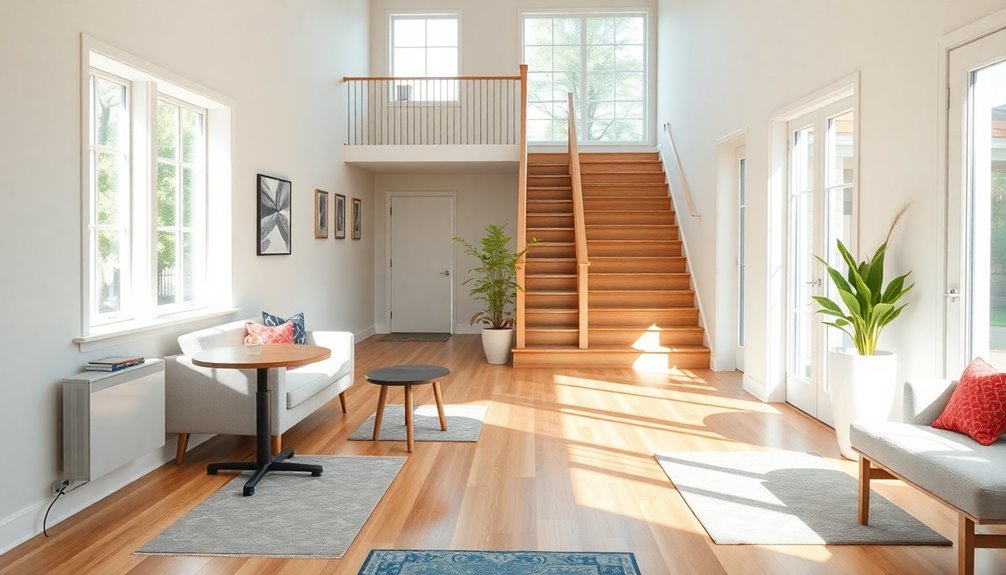
To enhance mobility throughout the home, it's essential to evaluate various design elements that directly impact daily living for older adults.
Prioritizing accessibility and safety can greatly improve their quality of life. Here are some key considerations:
- Upgrade to lever-style door handles for easier operation.
- Install slip-resistant flooring to minimize trip hazards.
- Reduce thresholds between rooms for smoother changes.
- Confirm hallways and passageways are wide enough for mobility aids.
- Incorporate grab bars in strategic locations for added support.
Additionally, consider using electric heated mattress pads to provide warmth and comfort, which can further enhance the overall living experience for older adults. Ensuring that the home is designed with safety considerations in mind can help prevent accidents and promote independence. Furthermore, maintaining proper nutrition is critical for overall health, which can positively influence mobility and energy levels in older adults.
Designing Elder-Friendly Staircases for Safety
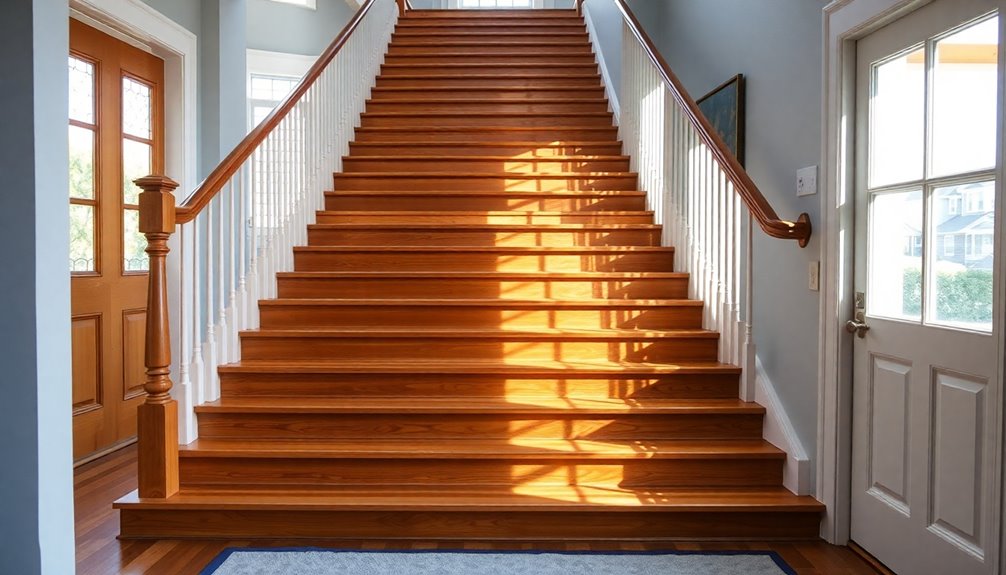
Designing elder-friendly staircases is vital for ensuring safety and accessibility in the home. To support older adults, install handrails on both sides of the staircase, ensuring they're properly anchored with a comfortable grip diameter. This prevents falls and provides stability during navigation. Additionally, incorporating higher fat content in the diet can help improve overall health and strength, which may contribute to better mobility. It's important to consider that emotional regulation challenges can affect an older adult's ability to navigate their environment safely.
Adequate lighting is important; use overhead lights to illuminate the stairs evenly and consider motion-sensor lights for added convenience. Enhance visibility by using contrasting colors for handrails against the staircase.
Additionally, minimize thresholds between rooms and avoid abrupt changes in floor height to reduce trip hazards. By implementing these design elements, you can create a safer environment that supports independence and confidence for older adults as they move throughout their home. Incorporating essential oils for dizziness relief can provide additional comfort for older adults experiencing balance issues on the stairs.
Adapting Bathrooms for Increased Safety for the Elderly
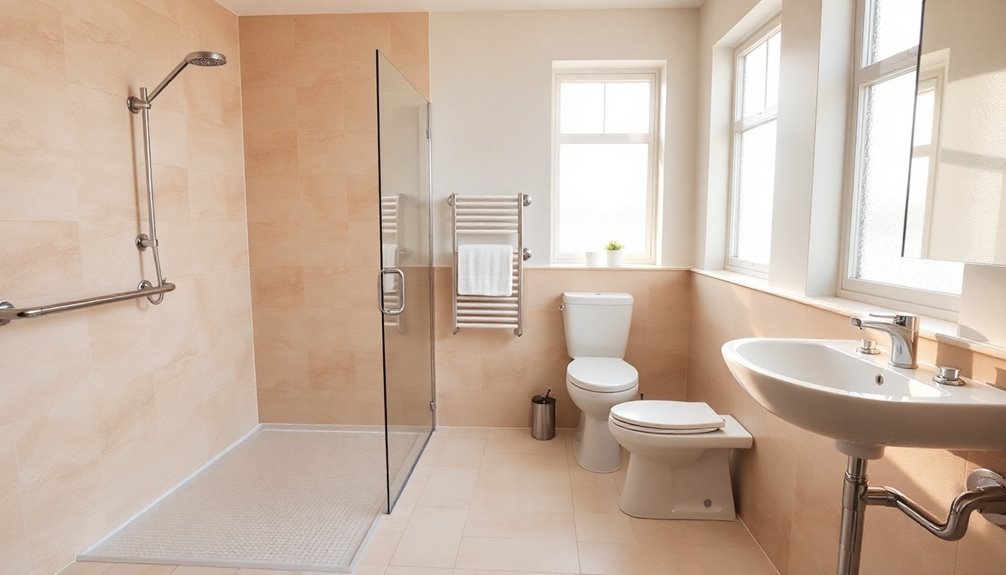
Since bathrooms can be particularly hazardous for older adults, adapting these spaces for increased safety is crucial.
Here are some key modifications you should consider:
- Install grab bars next to the toilet and inside the shower for better support.
- Choose non-slip flooring to reduce the risk of slipping on wet surfaces.
- Opt for walk-in showers with built-in seats and handheld showerheads to enhance accessibility.
- Consider higher toilets or raised toilet seats to make sitting and standing easier.
- Confirm adequate lighting, including motion-sensor lights, to improve visibility during nighttime visits.
These changes can greatly enhance safety and independence, allowing older adults to navigate their bathrooms with confidence and ease.
Optimizing Lighting for Aging Eyes

As your eyes age, they naturally require more light to see clearly, making it essential to optimize lighting in your home.
For older adults, increased illumination enhances visibility and safety, especially in high-traffic areas like hallways and staircases. Use bright, glare-free lighting to minimize accident risks.
Incorporating task lighting in spaces like reading nooks or kitchens helps focus light on specific activities, reducing strain on aging eyes. Motion-sensor lights can keep areas well-lit when in use, further preventing falls and injuries.
By implementing these thorough lighting strategies, you not only improve safety but also support independence and overall quality of life, allowing for easier navigation throughout your home.
Incorporating Social Spaces for Community Engagement

When you create pet-friendly outdoor areas, you not only invite furry companions but also encourage interactions among residents, fostering a vibrant community.
Community garden initiatives can serve as a hub for connection, where neighbors come together to share experiences and cultivate friendships.
These social spaces enhance the overall well-being of older adults, making them feel more engaged and connected.
Pet-Friendly Outdoor Areas
Creating pet-friendly outdoor areas greatly boosts community engagement and fosters social connections among residents.
These spaces not only enhance social interaction but also provide a welcoming environment for older adults. By designing accessible amenities and communal areas, you can help reduce feelings of isolation.
Consider these key features for your pet-friendly outdoor areas:
- Seating areas for relaxation and conversation
- Well-maintained pathways for easy navigation
- Waste stations and water fountains for convenience
- Designated play zones for pets to socialize
- Events or meetups to encourage intergenerational interactions
Incorporating these elements will enrich community connections, improve mental well-being, and create a vibrant atmosphere where everyone, especially older adults, can thrive together.
Community Garden Initiatives
Community garden initiatives not only beautify neighborhoods but also serve as essential social spaces that foster connections among residents, particularly older adults. These community gardens encourage interactions, helping seniors feel a sense of belonging and engagement.
Research shows that gardening can improve both physical health and mental well-being for older adults, offering light exercise and socialization opportunities. With accessible pathways and raised beds, these gardens cater to individuals with mobility challenges, making gardening feasible for everyone.
Additionally, strategic placement of community gardens within age-friendly housing developments enhances usage and promotes crucial social connections, combating isolation among older residents. By providing fresh produce, these gardens also contribute to food security, enriching the nutritional options for older adults living in food deserts.
Implementing Non-Slip Flooring and Safety Features
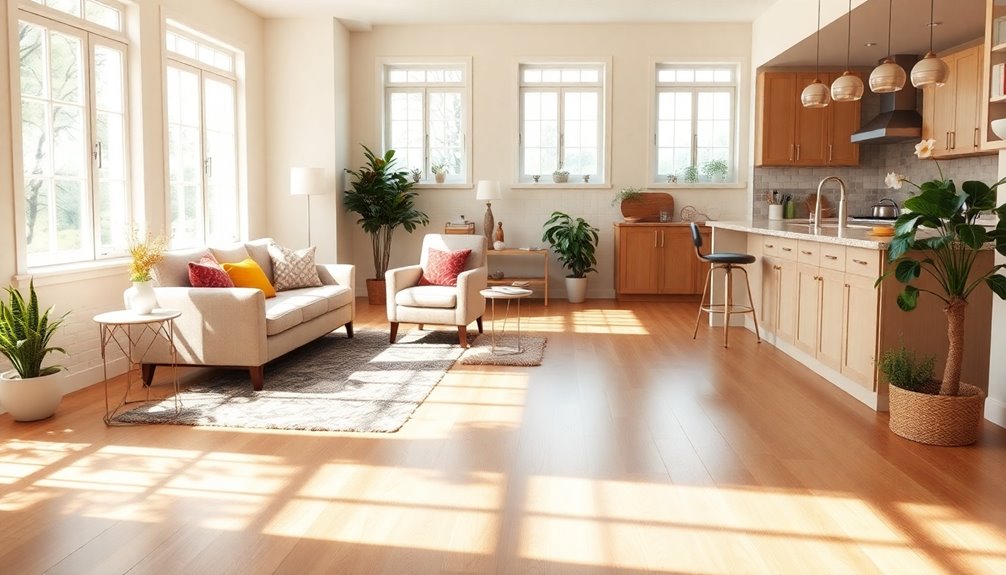
Implementing non-slip flooring and safety features is essential for reducing fall risks, especially for older adults. By prioritizing these elements in your home, you create a safer environment that promotes independence and mobility.
Here are some key considerations:
- Choose textured surfaces for bathrooms and kitchens.
- Install grab bars near toilets and in showers.
- Guarantee smooth changes between different flooring types.
- Regularly clean non-slip surfaces to maintain effectiveness.
- Use materials with high friction coefficients.
Incorporating these age-friendly design principles will greatly enhance safety and comfort for older adults, allowing them to navigate their space with confidence.
Frequently Asked Questions
What Are the Principles of Age-Friendly Design?
When considering age-friendly design principles, focus on inclusivity and accessibility.
You'll want to prioritize safety by eliminating barriers and adding features like grab bars and non-slip flooring.
Think about adaptability, ensuring spaces can evolve with changing needs.
Promote social connections by creating communal areas that encourage interaction.
Finally, incorporate sensory and cognitive support elements to enhance navigation and communication, making environments more comfortable and supportive for older adults as they age.
What Are the 8 Domains of Age-Friendly Communities?
Imagine a world where every corner invites you in.
The eight domains of age-friendly communities are Outdoor Spaces and Buildings, Transportation, Housing, Social Participation, Respect and Social Inclusion, Civic Participation and Employment, Communication and Information, and Community Support and Health Services.
Each domain works together, creating a tapestry of support that enhances your quality of life, ensuring you can thrive, engage, and feel valued in your community.
What Are the Four Characteristics of an Age-Friendly Community?
An age-friendly community has four key characteristics you should look for.
First, it prioritizes accessibility, making certain public spaces and transportation are easy to navigate.
Second, safety is essential, with well-lit paths and secure walking routes.
Third, social engagement is encouraged through communal areas and activities, helping you connect with others.
Finally, affordability guarantees you can find housing and services without financial strain, allowing you to live independently and comfortably.
What Is an Example of an Age-Friendly Initiative?
Did you know that nearly 40% of older adults report feeling lonely?
One great example of an age-friendly initiative is the development of community gardens.
These spaces not only encourage social interaction but also promote physical activity among older adults.
By participating in gardening, you can connect with neighbors, share stories, and cultivate relationships, all while enjoying the benefits of fresh air and exercise.
It's a win-win for fostering community and well-being!
Conclusion
By implementing these age-friendly design principles, you can create a secure and inviting living space that meets the needs of the elderly. Think about how much more comfortable and independent your loved ones will feel with these thoughtful modifications. Isn't it worth investing in their safety and well-being? Embracing these changes not only enhances their quality of life but also fosters a sense of community and connection. Let's make homes a place where everyone can thrive!
